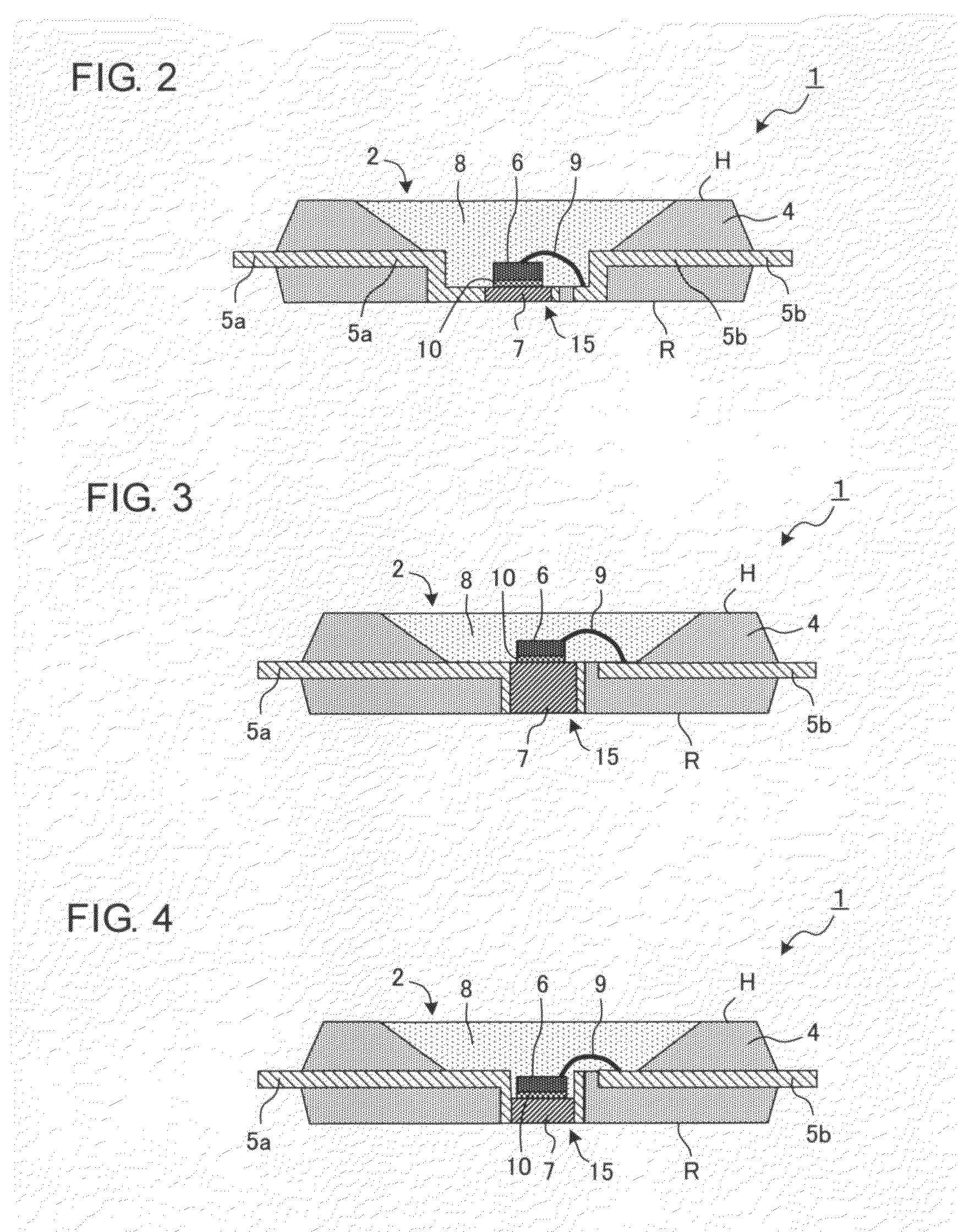Light emitting device
a light-emitting device and light-emitting technology, which is applied in the direction of semiconductor devices, basic electric elements, electrical equipment, etc., can solve the problems of shortening the life of leds, difficult to maintain air tightness, and shrinkage of conductive resins during hardening, and achieve excellent radiation performance and high air tightness
- Summary
- Abstract
- Description
- Claims
- Application Information
AI Technical Summary
Benefits of technology
Problems solved by technology
Method used
Image
Examples
first example
[0030]A light emitting device 1 according to a first example is described with reference to FIGS. 1A to 1C. FIG. 1A is a schematic top view of the light emitting device 1, FIG. 1B is a schematic view of a cross section taken along the line XX of FIG. 1A or FIG. 1C, and FIG. 1C is a schematic view seen from the rear side of the light emitting device 1. As is apparent from FIGS. 1A to 1C, a light emitting element 6 is mounted on a copper material 7 which is embedded in a lead frame 5a so as to pass through the lead frame 5a. A glass substrate 4 and the lead frame 5a are bonded to each other so that the light emitting element 6 is exposed from a recess (opening) 2 of the glass substrate 4.
[0031]As illustrated in FIGS. 1A to 1C, in the light emitting device 1, the lead frame 5a and a lead frame 5b are bonded to a rear surface R of the glass substrate 4. The recess 2 is formed in a front surface H of the glass substrate 4. The light emitting element 6 is mounted on a part of the lead fra...
second example
[0038]FIG. 2 is a schematic vertical cross-sectional view of a light emitting device 1 according to a second example. The second example differs from the first example in the shape of the lead frames 5a and 5b. Other structures are the same as those in the first example, and hence overlapping description is omitted. In this example, the lead frames 5a and 5b are embedded in the glass substrate 4. As illustrated in FIG. 2, one end of each of the lead frames 5a and 5b is exposed from the bottom surface of the recess 2 and from the rear surface R of the glass substrate 4, and another end thereof is protruded from the side surface of the glass substrate 4 (at a middle portion in height between the front surface H and the rear surface R). The one end of each of the lead frames 5a and 5b is bent toward the rear surface R side of the glass substrate 4 at a bottom portion of the recess 2. The upper surfaces of the lead frames are formed to be flush with the bottom surface of the recess 2, a...
third example
[0040]FIG. 3 is a schematic vertical cross-sectional view of a light emitting device 1 according to a third specific example. The third example differs from the second example in that the mounting portion 15 of the lead frame 5a, on which the light emitting element 6 is mounted, is formed to be thicker than other portions. Other structures are the same as those in the second example, and hence overlapping description is omitted as appropriate. By forming the mounting portion 15 of the lead frame 5a thicker than the other portions, the length of the bonding surface with the copper material embedded in the lead frame or the length of the bonding surface between the lead frame and the glass substrate is increased, and hence airtightness is improved.
[0041]As illustrated in FIG. 3, the lead frame 5a has one end including the mounting portion 15 which is exposed on the bottom surface side of the recess 2 and the rear surface R side of the glass substrate 4, and another end protruded from ...
PUM
 Login to View More
Login to View More Abstract
Description
Claims
Application Information
 Login to View More
Login to View More - R&D
- Intellectual Property
- Life Sciences
- Materials
- Tech Scout
- Unparalleled Data Quality
- Higher Quality Content
- 60% Fewer Hallucinations
Browse by: Latest US Patents, China's latest patents, Technical Efficacy Thesaurus, Application Domain, Technology Topic, Popular Technical Reports.
© 2025 PatSnap. All rights reserved.Legal|Privacy policy|Modern Slavery Act Transparency Statement|Sitemap|About US| Contact US: help@patsnap.com



